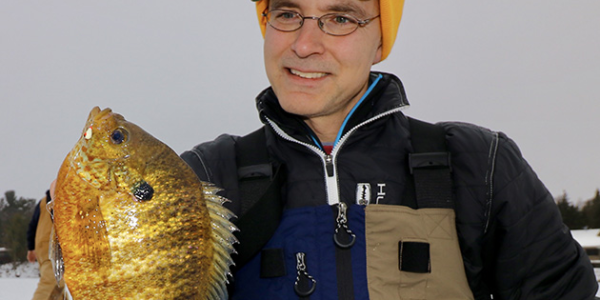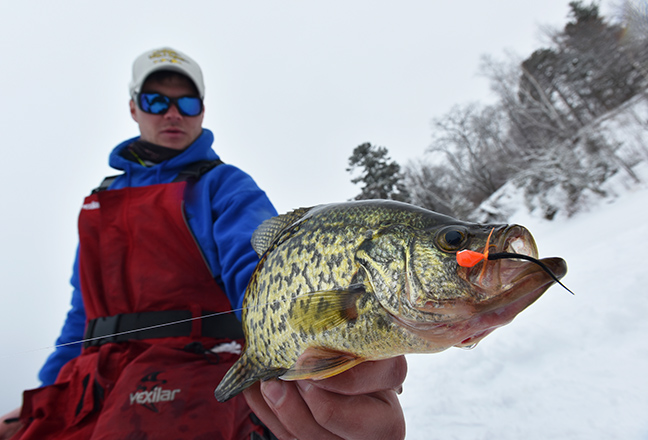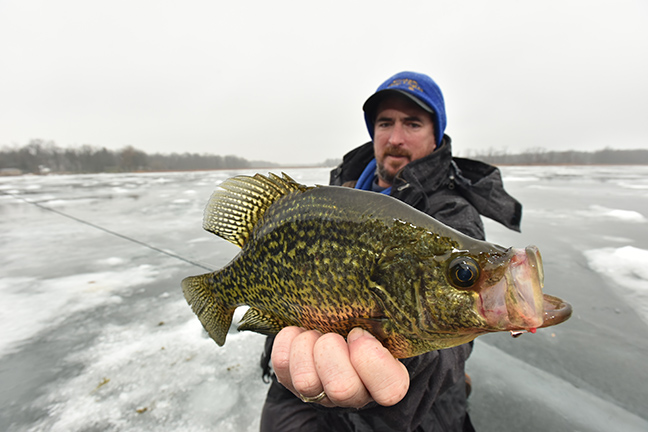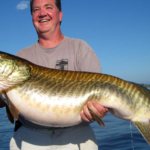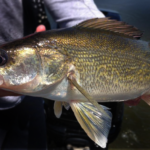Dr. Jason Halfen – The Technological Angler
Ice fishing’s essential targets – bluegills – prove perfect for both introducing anglers to the sport and mastering your game.
The hi-tech revolution that reshaped open-water fishing has also impacted anglers who chase fish through eight-inch holes. A slow walk down the aisles of your favorite retailer reveals all manner of electronic gadgetry, custom ice rods, thermally-insulted shelters, and scientifically advanced hard and soft baits, all of which are fine-tuned to the exacting requirements of the hardwater specialist.
The dazzling array of contemporary ice fishing equipment can be intimidating. Yet in its simplest form, ice fishing need not be more challenging than cutting a hole, presenting a bait and fighting a fish. And there is no better “starter species” than the bluegill.
What makes the bluegill such a worthy adversary lake? First, bluegills are abundant: when you find some, there are likely more where those came from. Second, bluegills are relatively predictable, typically found in areas that are easy to identify, and with appetites that conform to bankers’ hours. Third, a Ph.D. in fisheries biology is not required to trick bluegills into biting. Indeed, bluegills are generally quite receptive to both live and artificial offerings presented on small jigs or spoons.
Often creeping into bluegill realms at dusk, crappies make the perfect mixed-bag. This dandy fell to a Custom Jigs & Spins trifecta: Chekai tungsten jig with a Nuclear Ant Legs collar and Wedgee tail. Photo by Bill Lindner
Location is everything in the bluegill game
Remember those eager bluegills that hung around the dock all summer? They’re not under planking anymore…but aren’t far away. Start looking for hardwater bluegills by walking out to the nearest thick weed growth. If those weeds are still green beneath the lake’s ice cap, there’s an excellent chance that they will harbor bluegills. For the largest specimens, focus on the deep weededge, which generally ranges from 8- to 14-feet, dictated by the lake’s prevailing water clarity.
This deep weedline area is also where you chased panfish during the heat of the summer; a useful parallel that connects the behavior and locations of many species during the mid-season “dog-days” of midsummer and midwinter. So, if your database includes a couple of prime July or August bluegill holes, don’t be afraid to visit them again in February.
Oftentimes, however, near-shore weeds are overrun with tater-tots: juvenile panfish will briefly entertain, but ultimately drive you nuts. If this sounds familiar, leave those weedbeds in the rearview mirror and head for mid-depth flats, typically in 16-30 feet of water. Such soft-bottom flats are abundant with a favorite wintertime bluegill forage: larval forms of aquatic insects that live in the sediment.
This miniscule Custom Jigs & Spins Chekai jig represents the nearly microscopic waterlife fed on by panfish. Photo by Bill Lindner
Large schools of quality-sized bluegills often roam these flats, grazing on insect life like a herd of sheep. These schools will not be restricted to a particular depth, or be closely associated with structure; rather, they will travel to, and remain in, areas that are well-stocked with food. Once the bugs are gone, the bluegills will be too. Remember that on the flats, bluegills are highly mobile, so drill lots of holes. Multiple sonar returns within two or three feet of the bottom is a good indication that bluegills are underfoot.
Bluegill tackle, from soup to nuts
Now that you’ve found fish, let’s catch a bunch. With their primary forage being insects and larvae, focus on petite, tungsten-based presentations. A 4 mm FISKAS or Custom Jigs & Spins Chekai tungsten jig are excellent choices. Tip either with a waxworm or couple of spikes (maggots), and you’re in business.
Indeed, livebait enticers are foolproof, but even a beginner should experiment with plastics. They work. Try color-coordinating a Little Atom Nuggie with your FISKAS jig. Or match your Chekai to a soft plastic Wedgee, also by Custom Jigs & Spins. The slightest tremble of the rod tip will put these supple, precision plastics in motion.
Fish with light line to maximize feel and minimize its visibility to the fish. Choose premium grade, 2- 3-lb test, ice-fishing-specific fluorocarbon line. Buy the good stuff; it matters. The deeper you fish, the harder it is to feel your jig, let alone a strike, so choose line wisely. Seaguar Abrazx ICE and ASSO Ice Heavy are a couple highly-regarded fluorocarbons that are easily purchased online.
Attach your jig with a double surgeon’s knot or other loop knot. These knots dramatically reduce the amount of fish-repelling jig spin, an unnatural repellant that can significantly reduce bluegill catch rates.
I chase bluegills using ultra-light ice rods, with the St. Croix Mojo Ice MIR28UL and Frabill 28-inch Bro Series Combo being excellent selections for use in a shelter or hole-hopping. Both rods provide the sensitivity, action and power that allow me to detect subtle bites, enjoy the scrappy fights and handle the occasional largemouth or pike that are found cruising the same bluegill-infested flats.
Difference makers for bluegill wranglers
Bluegills are typically easy to find and are receptive biters. Nevertheless, some simple refinements to your presentation will catch more fish. First, reduce your jig stroke to a subtle shake. The best jig motion is often a simple quiver, the kind that you might produce after that 3rd cup of coffee. Quiver just a few inches above the bluegill returns on your fishfinder, and bites will follow in short order.
Second, consider an underwater camera to fine-tune your location and to monitor bluegill moods. When fishing weedbeds, there is no better tool for rapidly finding green weeds, and avoiding fish-repelling brown ones, than a portable, high-resolution underwater camera.
I favor the Aqua-Vu HD700i for habitat searches and as a visual bite monitor. There is no faster way to determine which jig motions are attracting biters than to watch how fish respond. Setting up your Aqua-Vu camera as a bite monitor is simple: cut a second hole adjacent to the one you intend to fish through, with the two holes 3-4 feet apart. Lower the camera and point it in the direction of your bait. A camera support like the Aqua-Vu Mo-Pod 3 eliminates the guesswork of locating your bait.
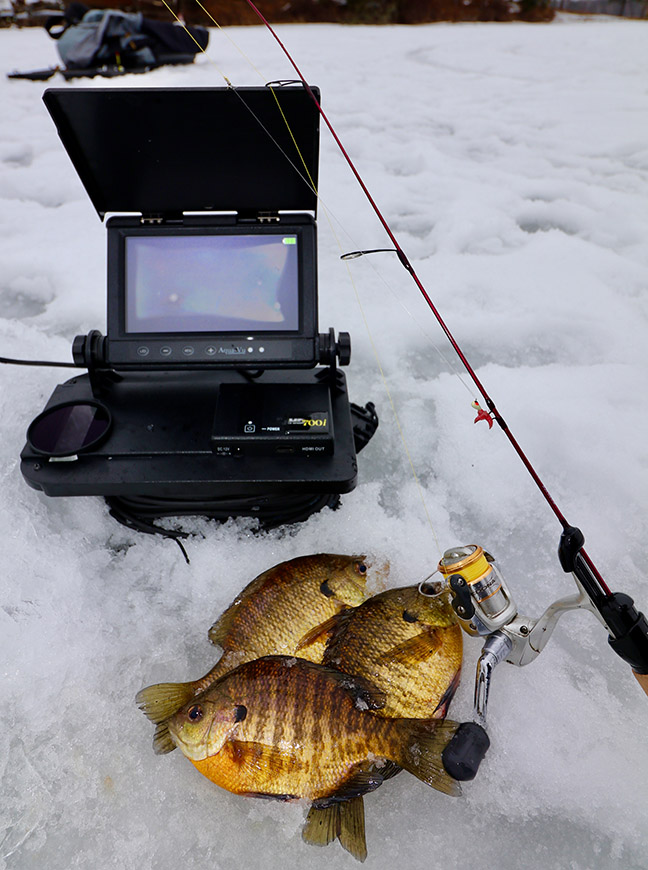
Looking to add more bluegills to the bucket? The Aqua-Vu HD700i is a difference-maker that will help you identify key habitat and monitor bluegill moods throughout the fishing day. Photo by the author
Finally, recognize that bluegills are often harbingers of things to come. When your hot bluegill bite suddenly turns ice-cold, it’s time to start preparing for a bass or pike bite. Moreover, a daytime bluegill hotspot often evolves into crappie town as the sun sets. These speckled panfish are drawn to the same food sources, but are typically more active at dusk and through the night.
For many anglers across the northland, ice fishing is far more than a simple pastime. Indeed, for the few brief months when ice caps our favorite lakes, dropping baits through eight-inch holes in the ice is an addiction, albeit a healthy one that gets us outside and brings us together with family and friends. For many ice addicts, the bluegill was their entry into the sport. Put these timely bluegill tips to use, and you’ll soon appreciate the meaning behind the phrase, “the tug is the drug.”
About the author: Dr. Jason Halfen owns and operates The Technological Angler, a company dedicated to teaching anglers to leverage modern technology to find and catch more and bigger fish. Learn more at


